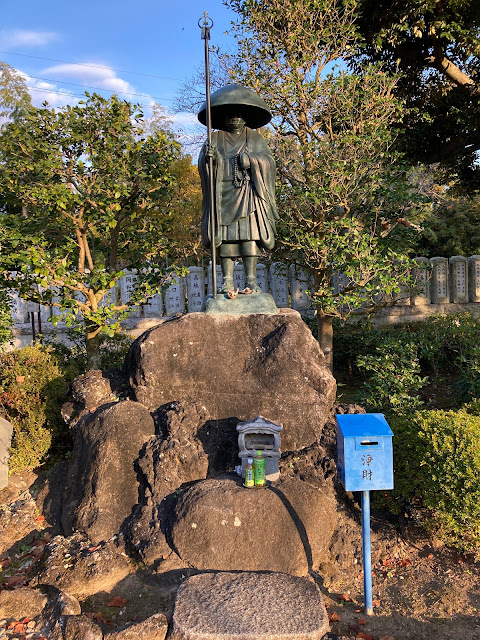The old street winds away between souvenir shops, galleries and restaurants offering various renditions of eel – as favoured by old-time pilgrims from Edo, according to the helpful brochure I picked up in the hotel, to strengthen their knees.
Strengthening your knees might be a good idea. The countryside here may look flat from a passing airliner but, like Kent or Kentucky, the landscape actually ripples away into wolds and swales (not the local words for them, of course).
Thus would-be visitors to Shinshō-ji, as the temple is formally called, must first scale a steep and sustained flight of stone steps. Fortunately, a fine rock garden provides an excuse for tarrying at half height.
At this hour, of course, actual visitors are few. But a chrysanthemum exhibition and a poster advertising the shichi-go-san ceremonies underline that this is a busily working temple with a full yearly calendar, not a tourist trap for passing travellers. But still I wonder what the deal is with this temple’s “mountain” suffix.
The answer comes from a straw-hatted pilgrim, or rather a bronze statue of one. No, not just a pilgrim, but the Daishi himself, the monk who – says H Byron Earhart in his magisterial book on Mt Fuji – most radically altered the trajectory of Japan’s mountain religions.
Before Kōbō Daishi, mountains were themselves the objects of worship. But Kūkai, as he was also known, saw them more as places of spiritual retreat. “According to the sutra, meditation should be practised preferably on a flat area deep in the mountains … for the benefit of the nation and those who desire to discipline themselves,” he wrote.
And so, to this day, temples of the Shingon sect that Kūkai founded are known as "mountains", often including the character for 'yama' in their names. I should have guessed - we've visited such a "mountain temple" before.
In fact, Shinshō-ji was founded by a disciple of Kūkai, not the Daishi himself. But the master's spirit seems to have faithfully imprinted itself on this far-flung outpost of the Shingon sect. I’m now wandering up another flight of stone steps towards the temple’s highest walks, which are surmounted by a “peace pagoda”.
Is it my imagination, or do the gardens take on a wilder character here, as if recalling the magnificent cryptomeria forests that surround the founder’s monastery on Kōya-san? It seems I’m not the only one to think so. This writer captures their atmosphere perfectly:
The natural Nature which is apt to be forgotten carelessly. Something recalling me to this is left in the Naritasan park. The park overflows in the trees and plants and Nature, and thought to respect all life of the thing which straight of the Buddhism arranges is incorporated …When the stairs near the light temple in the precincts are gone down, a waterfall of the donation that light comes in from a grove turns up from a huge rocky mountain…”
The light of a late autumn sunrise is starting to slant in over the groves. It is time to go down the mountain. In front of the Daihondō, a gardener is filling his watering cans for the daily round. “What splendid gardens,” I say as I pass, and he smiles. At Narita-san, natural Nature is in no danger of being forgotten carelessly.








No comments:
Post a Comment